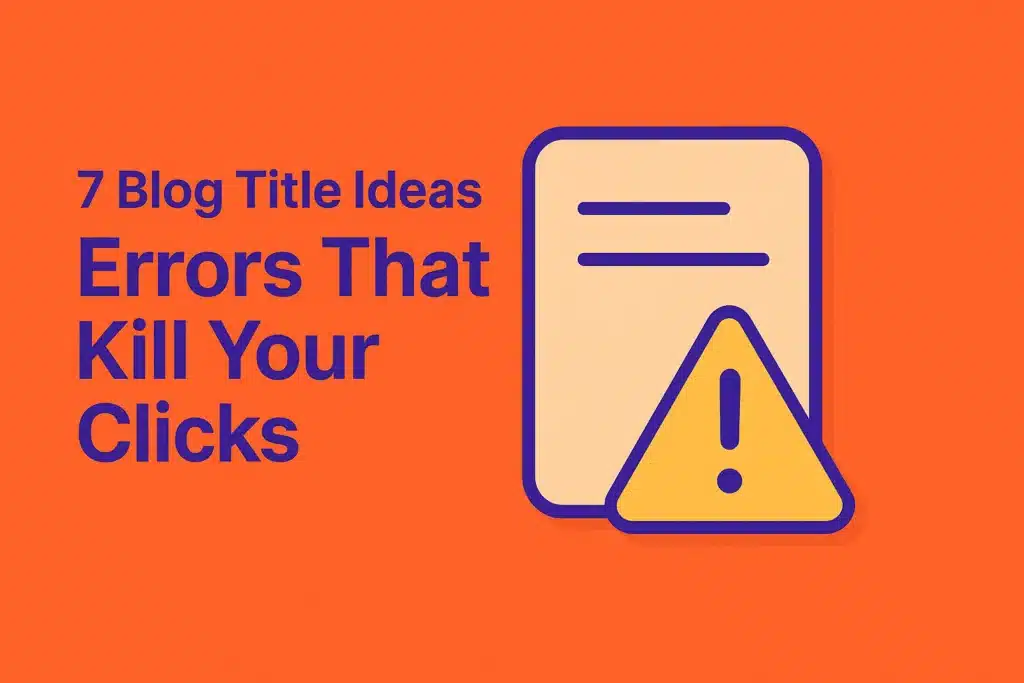Many bloggers wonder why certain articles attract a flood of readers while others quietly sink. Readers often decide whether to click based on one factor: the headline. Strong titles spark interest and encourage visitors to explore your post. Weak titles lose the competition instantly. In this blog, we examine typical mistakes that cause headlines to fail, plus proven methods to gain more clicks and keep readers interested.
Why Blog Titles Matter More Than You Think
Blog titles influence that important first impression of your content. They stand between a potential reader and everything else in your post. Effective headlines create interest, create urgency, and promise valuable information. A strong title can even outrank competitors in search results, raising your exposure while attracting steady daily traffic.
Understanding user click behavior
Users judge content within seconds. A dull headline often means no click. Many assume great text alone will carry a blog, yet readers rarely see that text if the title lacks compelling hooks. Interest and urgency cause clicks. Without those elements, quality content stays overlooked. Hooks connect between user and article.
The role of compelling blog headlines in SEO
Search engines scan titles first. When your headline includes targeted keywords, it matches your post with user searches. If the title fails, you might not be seen. Clear keywords help Google connect your content to real queries. Effective headlines also boost clicks, which improves search rankings. That quick spark creates the foundation for exposure. Higher positions attract traffic.
How bad blog titles weaken your content strategy
Poor headlines disrupt even the best-planned content strategy. A dull or misleading title repels readers, resulting in high bounce rates and lost trust. Repeated weak titles decrease trust and reduce return visits. This pattern weakens long-term growth because each missed click means fewer loyal followers, which decreases your content’s progress. Momentum grows with strong hooks.
7 Blog Title Ideas Errors That Kill Your Clicks
Many creators have trouble with consistent headline performance. Certain problems harm click-throughs, weakening great content. Repetitive titles, unrelated words, or vague language can drive potential readers away. Wrong approaches weaken trust in your brand or blog. Seeing these seven error types helps you adjust your strategy before more clicks are lost.
1. Using clickbait that fails to deliver value
According to ZoomSphere Blog, 58.5% of searches end before anyone clicks, which means readers leave fast. Exaggerated headlines might grab attention yet disappoint visitors who expect true insights. Fake promises erode trust, spark high bounce rates, and damage your trust. A strong hook only works if the content maintains interest with clear, helpful information and genuine answers.
2. Ignoring basic headline writing tips for clarity
Many writers skip clarity and lose readers quickly. Out of everyone who sees a headline, only 20% continue reading the article (WordStream). Overly vague or complex titles confuse. Readers want a short statement that matches their needs. Straightforward language clarifies, shows what to expect, and leads to more engagement. These tips ensure your headlines appeal to interest.
3. Including too many keywords without meaning
Keyword stuffing confuses readers and search engines. A headline filled with repeated terms feels fake and unappealing. Instead of increasing exposure, heavy repetition harms readability and lowers trust. Fewer, well-selected words serve your blog title ideas better. Meaningful keywords show relevance; careless insertion leads to leaving before the reader even clicks. Readers appreciate concise titles with relevant topics.
4. Forgetting relevance while picking blogging topics
Forgetting a topic’s relevance harms reach. The web guides most purchase decisions, so titles must address real questions or trends (SEO.co). Unrelated themes seem unrelated from user interests. Without connection, even well-written pieces fail. Readers want practical solutions and new viewpoints. Adjusting topics stops your blog from becoming irrelevant. Save attention-grabbing subjects for when they match your audience.
5. Writing bland titles with no urgency or angle
Titles without urgency or a distinct angle go unnoticed. They lack a unique angle or incentive for clicking. If your headline seems ordinary, readers ignore. Vague words hide your post amid many competing pages. Adding a direct angle or mild time element encourages readers to read more. Emotional appeals help your message be noticed.
6. Not matching audience intent in blog post naming
Titles that miss audience intent don’t interest. Some bloggers forget to write for users, not just search engines (Digital Marketing Institute). Bland or technical names confuse readers, who then leave. Align your blog post naming with user goals, questions, or problems to show real connection and reduce quick departures. Readers skip anything that feels confusing.
7. Skipping A/B testing for how to write blog titles
A/B testing compares two headline versions to see which draws clicks. Skipping it leaves you guessing what connects with your audience. Even small changes, like using numbers or adjusting tone, can affect visits. Testing shows likes, helps ongoing progress, and stops repetitive uncertainty. Titles improve through tested user feedback. Test cycles adapt to changing reader habits.
Fixing Titles with Proven Headline Writing Tips
Stronger headlines need tested structures. Clear benefits, numbers, and engaging words encourage clicks. Combine action verbs with real helpful approaches to show clear benefits. Avoid exaggerating or stuffing extra phrases. Instead, focus on direct promises. This approach improves your blog titles to attract readers and build long-term trust.
Power words that grab instant attention
Words like “easy,” “secrets,” or “now” can create quick interest. These spark interest and connect with needs. Power words also signal specificity and urgency in your headline. They make your message more memorable, yet avoid forced hype. The best approach combines emotional triggers with honesty, so readers want to click. Carefully chosen power words boost blog ideas.
Smart ways to include blog title ideas with intent
Tie your headline to a real question or goal. Use phrases like “how to,” “reasons why,” or “tips for” to explain simply. Think about who your audience is and what they need. Stress direct solutions or benefits. This method combines blog title ideas with genuine intent, increasing click-through rates. Showcase step-by-step guidance or verified points to appeal.
Engagement tactics that drive click-throughs
Including numbers or direct benefits in headlines gets quick readers. Studies indicate eight out of ten people read a headline, but only two read further (okwrite.co). To increase engagement, consider time-based words (“today,” “fast”), ask a question, or offer useful information. Ensure the body satisfies curiosity, or readers won’t stay. Testing multiple versions refines results. Measure results to measure each headline’s performance.
Conclusion
Headlines influence how people discover and evaluate your blog. By seeing key errors—like unclear messaging, unrelated topics, or clickbait promises left unfulfilled—you protect your trust. Each improvement to clarity, relevance, and trust helps attract new readers and bring back returning ones. Careful testing ensures your approach remains informed and flexible. Highlighting power words, matching user intent, and showing real value in the title shows the real goal of your content. Over time, stronger headlines increase interest and drive consistent clicks, giving you a healthy platform for growth. Minor changes add up and sustain your blog’s influence in busy competitive spaces.
FAQs
What makes blog title ideas rank better on Google?
How can I use headline writing tips without sounding fake?
What are common blogging topics that inspire viral titles?
How do I make compelling blog headlines for B2B?
Are blog post naming tips different for beginners?
What’s a fast way to learn how to write blog titles?

Ridam Khare is an SEO strategist with 7+ years of experience specializing in AI-driven content creation. He helps businesses scale high-quality blogs that rank, engage, and convert.



